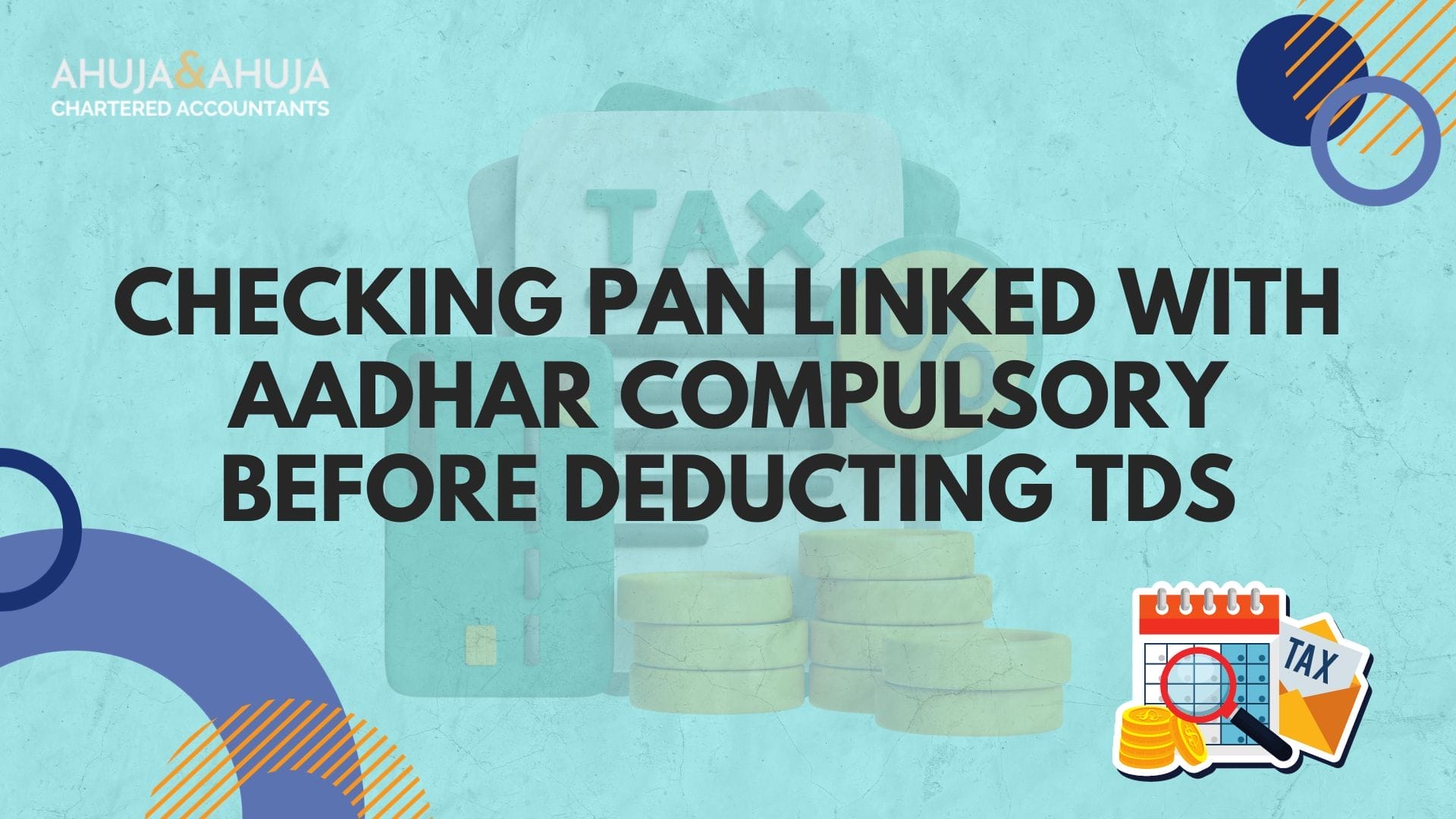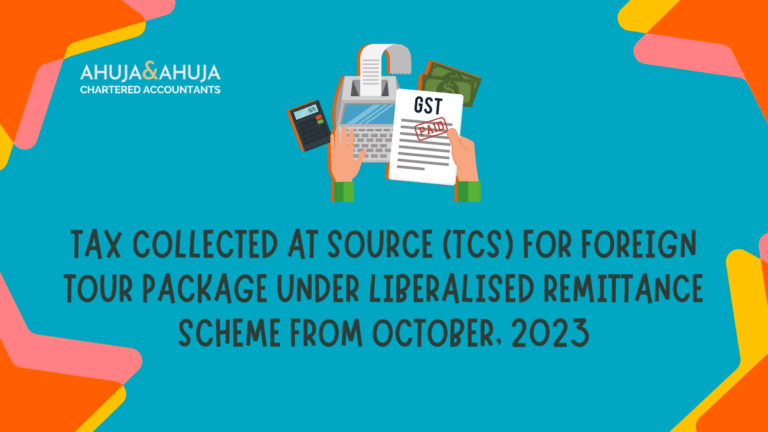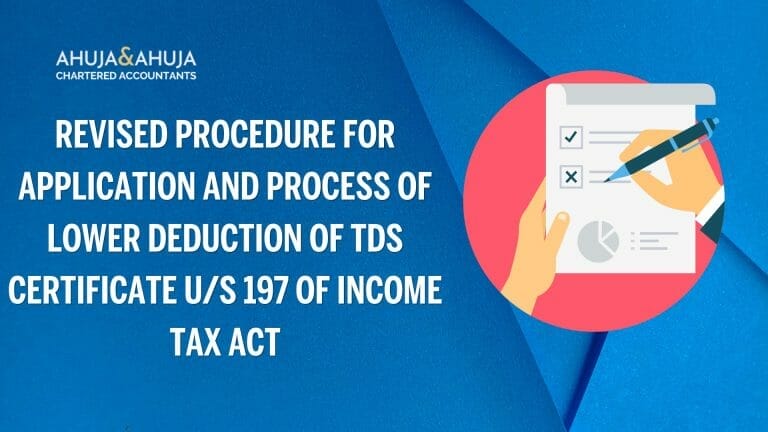TDS Deductors Beware: Checking PAN Linked with Aadhar Compulsory before Deducting TDS
Tax Deducted at Source (TDS), a critical component of India’s taxation system, acts as a method for collecting tax at the source of income. Here’s what you need to know:
- TDS As A Method of Tax Collection: It’s a mechanism where a person (deductor), before making payments under various categories such as salary, rent, or commission, deducts a certain percentage of the amount as tax and remits it to the government on behalf of the payee (deductee).
- Role of PAN and Aadhaar: The Permanent Account Number (PAN) is a unique identifier assigned to all taxpayers in India, while Aadhaar is a unique identity provided to residents. Both serve as crucial Identity and address proof, which helps in curbing tax evasion and ensuring a seamless tax collection system.
Recent changes in the tax laws have brought about a new compliance requirement, shaking up the established TDS deduction process. Effective from 1st April 2023, the government has mandated that the PAN of the deductee must be linked with their Aadhaar before a deductor can proceed with the TDS deduction. This move ensures that the tax information and status of residents are cohesive and up-to-date as per the records of the Income Tax Department.
Understanding the Amendment:
- The Income Tax Act and Rule 114AAA lay down the new law requiring the linking of PAN with Aadhaar prior to TDS deduction.
- In the event of non-linking, the deductor is compelled to deduct TDS at a higher rate, specifically at 20%, as per Section 206AA in conjunction with Rule 114AAA(3)(iii).
What is the Amendment’s Purpose?
The move aims at ensuring a streamlined, efficient, and non-adversarial tax system, enabling better tax compliance. It deters the inefficiencies in the tax collection mechanism related to discrepancies between Aadhaar and PAN databases.
Deductors’ Duty of Care:
It’s imperative for TDS deductors, in their due diligence, to verify the linkage status between PAN and Aadhaar. The process for verification is straightforward and can be accomplished by logging into TRACES (TDS Reconciliation Analysis and Correction Enabling System), navigating to the “Dashboard,” and using the “PAN Verification” option within “Quick Links.”
Failure to adhere to this requirement won’t just put the deductors at risk of non-compliance but will also lead to unnecessary financial repercussions for the deductee. That’s why as a deductor, ensuring that this critical check is part of your TDS and TCS return filings process, is now more important than ever.
Impact of the PAN-Aadhaar Linking Requirement
Consequences for Deductors:
As a TDS deductor, it is essential to understand the implications of the new PAN-Aadhaar linking requirement. Here’s what you need to know:
- Verification Responsibility: The responsibility lies with the deductor to verify whether the PAN of the deductee is linked with their Aadhaar. Failure to do so may result in non-compliance, leading to penalties and legal repercussions.
- Higher TDS Rate: If the deductor finds that the PAN is not linked with Aadhaar, they are required to deduct TDS at a higher rate of 20%, as per Section 206AA of the Income Tax Act along with Rule 114AAA(3)(iii). This increased rate aims to encourage deductees to link their PAN with Aadhaar and ensure tax compliance.
- TCS Applicability: Additionally, Tax Collected at Source (TCS) may also be applicable under Section 206CC and Rule 114AAA(3)(iv). Deductors should be aware of this provision and comply accordingly.
- Demand for TDS Difference: The Income Tax Department has initiated the process of creating a demand for the difference in TDS between the normal rate and the higher rate due to non-linking of PAN with Aadhaar. Deductors may receive notices and demands for payment in such cases.
It is crucial for deductors to adapt their processes and ensure compliance with the new requirement, including the verification of PAN-Aadhaar linkage before deducting TDS.
Implications for Deductees:
The PAN-Aadhaar linking requirement also has implications for the deductees. Here’s what deductees should know:
- Higher TDS Deduction: If deductees fail to link their PAN with Aadhaar, they may face higher TDS deductions at a rate of 20%. This may impact their cash flow and finances, as more tax will be deducted at source.
- Importance of PAN-Aadhaar Linking: To avoid any inconvenience, deductees must prioritize linking their PAN with Aadhaar before the TDS deduction date. Linking these two crucial identifiers ensures smooth processing of TDS deductions and prevents higher rates from being applied.
- Procedure to Link PAN with Aadhaar: Deductees can link their PAN with Aadhaar through various methods, including the Income Tax Department’s official website, via SMS, or through the Aadhaar OTP (One-Time Password) authentication process. Following these procedures promptly will help avoid unnecessary tax deductions.
Deductors and deductees must work together to ensure compliance with the new PAN-Aadhaar linking requirement. By fulfilling these obligations, both parties can mitigate any potential financial and legal consequences.
Step-by-Step Guide: PAN-Aadhaar Linking for Compliance
For Deductors:
- Verify PAN-Aadhaar Linking Status: Before deducting TDS, log in to TRACES (TDS Reconciliation Analysis and Correction Enabling System) using the URL https://www.tdscpc.gov.in/app/login.xhtml. Access the “Dashboard” and navigate to “PAN Verification” in the “Quick Links” menu. Verify the PAN-Aadhaar linkage status for each deductee.
- Update Internal Processes: Revise your TDS deduction processes to incorporate the PAN-Aadhaar verification step before initiating any deductions. Ensure that your team is aware of the new compliance requirement and understands the implications of non-compliance.
- Communicate with Deductees: Inform your deductees about the importance of linking their PAN with Aadhaar and the consequences of non-compliance. Encourage them to complete the linking process before the TDS deduction date to avoid higher TDS deductions.
- Maintain Documentation: Maintain proper documentation as evidence of verifying the PAN-Aadhaar linkage status for each deductee. This documentation will serve as a record of your compliance efforts and protect you from any potential penalties or disputes in the future.
For Deductees:
- Link PAN with Aadhaar: It is crucial for all taxpayers to link their PAN with Aadhaar to ensure tax compliance. Follow these steps to link your PAN with Aadhaar:a. Visit the Income Tax Department’s official website or click here.
b. Look for the “Link Aadhaar” option and click on it.
c. Enter your PAN, Aadhaar number, and other required details as prompted.
d. Double-check the accuracy of the information entered, verify the captcha code, and click on “Link Aadhaar” to submit the request. - Verification with Aadhaar OTP: If you have a registered mobile number linked with both your PAN and Aadhaar, you can complete the verification process through an Aadhaar OTP. Here’s how:a. Visit the Income Tax Department’s e-filing portal or click here.
b. Select the “Quick Links” option and click on “Link Aadhaar.”
c. Click on the “Link Aadhaar” button.
d. Select the “OTP” option and enter the Aadhaar-registered mobile number.
e. Enter the OTP received on your mobile, and click on “Submit” to complete the verification process. - SMS-Based Verification: If you don’t have access to the internet or prefer an alternative method, you can link your PAN with Aadhaar via SMS. Follow these steps:a. Send an SMS from your registered mobile number to 567678 or 56161 in the following format: “UIDPAN <12-digit Aadhaar number> <10-character PAN>.”
b. Ensure that the PAN and Aadhaar details entered are accurate.
c. You will receive an SMS confirmation once the linking process is successful.
By following these steps, both deductors and deductees can ensure compliance with the new PAN-Aadhaar linking requirement and avoid unnecessary hassles and financial implications.
FAQs: PAN-Aadhaar Linking Requirement
What happens if a deductee’s PAN is not linked with Aadhaar after 1st April 2023?
If a deductee’s PAN is not linked with Aadhaar after 1st April 2023, the deductor is required to deduct TDS at a higher rate of 20% as per Section 206AA and Rule 114AAA(3)(iii). It is essential for deductees to link their PAN with Aadhaar to avoid higher TDS deductions.
How to check if PAN is linked with Aadhaar on TRACES?
To check the PAN-Aadhaar linkage status on TRACES, follow these steps:
- Log in to TRACES using the URL https://www.tdscpc.gov.in/app/login.xhtml.
- Access the “Dashboard” after logging in.
- In the “Quick Links” menu, click on “PAN Verification”.
- Verify the PAN-Aadhaar linkage status for each deductee listed.
What should a deductor do if they deduct TDS at a lower rate due to unawareness of the new rule?
If a deductor has deducted TDS at a lower rate due to unawareness of the new PAN-Aadhaar linking rule, it is crucial to rectify the situation. The deductor should immediately comply with the requirement and start deducting TDS at the higher rate of 20% for deductees whose PAN is not linked with Aadhaar. It is recommended to consult with a tax professional and rectify any non-compliance issues promptly.
Can a deductee claim a refund if TDS is deducted at a higher rate due to non-linkage of PAN with Aadhaar?
Yes, a deductee can claim a refund if TDS has been deducted at a higher rate due to non-linkage of PAN with Aadhaar. The deductee can file an income tax return and claim the excess TDS deducted as a refund while reconciling their tax liability. It is advisable to consult with a tax professional to ensure the correct procedure for claiming a refund.
Disclaimer
The materials provided herein are solely for educational and informational purposes. No attorney/professional-client relationship is created when you access or use the site or the materials. The information presented on this site does not constitute legal or professional advice and should not be relied upon for such purposes or used as a substitute for professional or legal advice.






